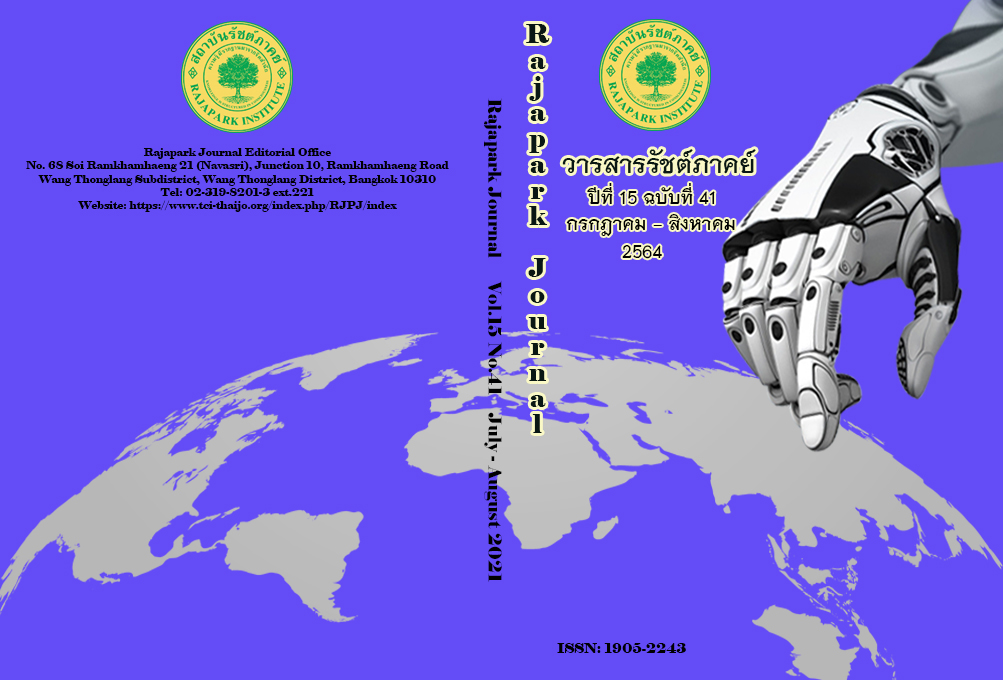Factors Influencing Return on Investment in Equity Mutual Fund in Thailand
Main Article Content
Abstract
In this study, we focused on the analysis of influencing factors, which are involved return on investment in equity mutual fund in Thailand. This study was a quantitative study. The set of sampling data came from 274 equity mutual funds, which reach out 5 years or more maturity date at the end of 2020. From 2016 to 2020, rate of return was measured from the change in net asset value plus dividend. As mentioned above, internal factors are examined by systematic risk measured by beta, total risk measured by standard deviation. And fund-specific factors are composed of financial ratios and fund maturity. External factors are indicated by Gross Domestic Product growth. Multiple Linear Regression is applied to investigate the influencing factors of return rate on investment in equity mutual fund. The results showed that both internal and external factors statistically significantly influence return rate in equity mutual fund. The positive influencing factors, which are arranged in descending order, are working capital to total asset and Gross Domestic Product growth. The negative influencing factors, which are arranged in descending order, are standard deviation, asset turnover and fund maturity. The results from this study confirmed the importance of both internal and external factors in equity mutual fund investment. Investors suggested to choose to invest in equity mutual funds with high working capital. And they should not choose to invest in equity mutual funds with high total risk and high asset turnover.
Article Details
Views and opinions appearing in the Journal it is the responsibility of the author of the article, and does not constitute the view and responsibility of the editorial team.
References
Association of Investment Management Companies. (2021). Increasing Trend of Mutual Fund Accounts per Number of Deposit Accounts 1997-2019. Retrieved May 1, 2021, from www.aimc.or.th.
Budiono, D. P., & Martens, M. (2010). Mutual Funds Selection based on Funds Characteristics. The Journal of Financial Research, 33(3), 249-265.
Dewi, T. F. (2017). Effect of Curent Ratio, Working Capital to Total Assets, Debt to Total Assets, Return On Assets and Total Asset Turnover on Profit Changes in Retail Sub-Sector Trading Companies Listed on the Indonesia Stock Exchange. Department of Accounting, Faculty of Economics, Raja Ali Haji Maritime University, Tanjungpinang.
Ferreira, M. A., Miguel, A. F., & Ramos, S. B. (2006). The Determinants of Mutual Fund Performance: A Cross-Country Study. Review of Finance, European Finance Association, 17(2), 483-525.
Imsombat, P. (2015). Compare The Ability to Explain the Stock Price Between the Two Types of Financial Ratios: Evidence from The Beverage Industry from Stock Exchange of Thailand. Master of Business Administration. Bangkok University.
Kasemsuk, K. (2007). Investing in Real Estate Funds. Master of Business Administration. Kasetsart University.
Keeranan, S. (2003). Fundamentals of Finance: Principle Rationale Perspective And Analysis. Bangkok: Fuengfah Printing.
Klongveerachai, S. (2014). The Study of Relationship Between financial Ratios and Stock Price Changes of Listed Companies in Main Sectors in the Stock Exchange of Thailand. Master of Business Administration. Bangkok University.
Nguyen, H. T., & Nguyen, D. T. N. (2019). The Impact of Country-Level and Fund-Level Factors on Mutual Fund Performance in Vietnam. Journal of Economics and Development, 21(1), 42-56.
Persson, M., & Karlsson, T. (2005). Mutual Fund Performance - Explaining the performance of Swedish domestic equity mutual fund by using different fund characteristics. School of Business, Economics and Law. Goteborg University.
Phakularn, S. (2015). The Relationships Between Financial Ratios and The Largest Market Capitalized Companies’ Stock Prices: Evidence from Stock Exchange of Thailand’s All Sector Indices. Master of Science, Finance. Bangkok University.
Real Statistics Using Excel. (n.d.). Durbin Watson Table. Retrieved May 25, 2021, from https://www.real-statistics.com/statistics-tables/durbin-watson-table/
Rehman, A., & Baloch, Q. B. (2016). Factors Affecting Mutual Fund Performance In Pakistan: Evidence From Open Ended Mutual Funds. Abasyn Journal of Social Sciences, 9(2), 211–219.
Rongngern, A. (2016). The Relationship Between Financial Ratios and Stock Returns in the Construction Material Sector of the Stock Exchange of Thailand. Master of Business Administration. Thammasat University.
Sangkaew, J. (2002). Investment. (5th ed.). Bangkok: Thammasat University.
Srisuriyaporn, N. (2015). The Relationship Between Financial Ratios and Market Price of Securities of Banking Groups Listed in the Stock Exchange of Thailand. Master of Business Administration. Bangkok University.
Thailand Securities Institute, The Stock Exchange of Thailand. (2005). Investment in Mutual Funds. Retrieved May 26, 2021, from www.set.or.th
Thailand Securities Institute, The Stock Exchange of Thailand. (2009). Meaning of Return. Retrieved May 26, 2021, from www.set.or.th.
Thai Mutualfund. (n.d.). Net Asset Value of Equity Fund. Retrieved December 26, 2020, from www.thaimutualfund.com
Thamrongrakkul, S. (2008). A Comparative Study of Performance and Factors Determining Return
of Real Estate Fund in Thailand. Master of Economics. Thammasat University.
The Bank of Thailand. (2021). 12-month fixed deposit interest rates for general customers. Retrieved March 30, 2021, from www.bot.or.th.
The Securities and Exchange Commission, Thailand. (2021). Number of Equity mutual funds and number of mutual fund. Retrieved May 26, 2021, from www.sec.or.th.
The Stock Exchange of Thailand. (2021). The Stock Exchange of Thailand Total Return Index (SET TRI). Retrieved January 26, 2021, from www.set.or.th.
Untong, A. (2007). An Introduction to EViews Program Manual. Social Research Institute. Chiang Mai University.
Vorapongsathorn, T. (2018). Multiple Regression Analysis. Retrieved May 26, 2021, from www.oec.anamai.moph.go.th
Washiramontree, N., & Suwanna, T. (2019). The Relationship Between Financial Ratios and Stock Returns of Thai Listed Companies: A Case Study of Information and Communications Technology Sector. Pathumthani University Academic Journal, 11(1), 69-80.
Yamane, T. (1973). Statistics: An Introductory Analysis (3rd ed.). New York: Harper & Row.


